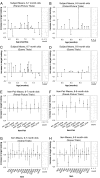At 6-9 months, human infants know the meanings of many common nouns
- PMID: 22331874
- PMCID: PMC3295309
- DOI: 10.1073/pnas.1113380109
At 6-9 months, human infants know the meanings of many common nouns
Abstract
It is widely accepted that infants begin learning their native language not by learning words, but by discovering features of the speech signal: consonants, vowels, and combinations of these sounds. Learning to understand words, as opposed to just perceiving their sounds, is said to come later, between 9 and 15 mo of age, when infants develop a capacity for interpreting others' goals and intentions. Here, we demonstrate that this consensus about the developmental sequence of human language learning is flawed: in fact, infants already know the meanings of several common words from the age of 6 mo onward. We presented 6- to 9-mo-old infants with sets of pictures to view while their parent named a picture in each set. Over this entire age range, infants directed their gaze to the named pictures, indicating their understanding of spoken words. Because the words were not trained in the laboratory, the results show that even young infants learn ordinary words through daily experience with language. This surprising accomplishment indicates that, contrary to prevailing beliefs, either infants can already grasp the referential intentions of adults at 6 mo or infants can learn words before this ability emerges. The precocious discovery of word meanings suggests a perspective in which learning vocabulary and learning the sound structure of spoken language go hand in hand as language acquisition begins.
Conflict of interest statement
The authors declare no conflict of interest.
Figures



References
-
- Polka L, Werker JF. Developmental changes in perception of nonnative vowel contrasts. J Exp Psychol Hum Percept Perform. 1994;20:421–435. - PubMed
-
- Werker JF, Tees RC. Cross-language speech-perception: Evidence for perceptual reorganization during the 1st year of life. Infant Behav Dev. 1984;7:49–63.
-
- Kuhl PK, Williams KA, Lacerda F, Stevens KN, Lindblom B. Linguistic experience alters phonetic perception in infants by 6 months of age. Science. 1992;255:606–608. - PubMed
-
- Gervain J, Mehler J. Speech perception and language acquisition in the first year of life. Annu Rev Psychol. 2010;61:191–218. - PubMed
-
- Jusczyk PW, Aslin RN. Infants’ detection of the sound patterns of words in fluent speech. Cognit Psychol. 1995;29:1–23. - PubMed
Publication types
MeSH terms
Grants and funding
LinkOut - more resources
Full Text Sources
Medical

